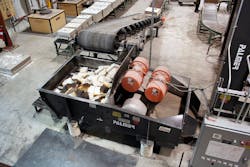Most everyone realizes that sand reclamation is necessary for cost reducing and environmental requirements. While the popularity of sand reclamation certainly resulted from increasing sand prices (caused primarily by the demand for fracking), there are few processes that provide as many immediate benefits as sand reclamation.
Reducing the cost of sand is by far the most attractive consideration for sand reclamation, though lowering disposal and transportation costs are equally attractive. Couple these with reducing your environmental footprint and you realize that reclaiming sand is just good business.
One of the most overlooked benefits from sand reclamation is quality assurance. Controlling your materials through an in-house system will enhance the quality of your castings; because better sand makes better castings.
Higher casting quality. One of the main advantages of thermally reclaimed sand is that it helps foundries lessen expansion defects. This is especially critical for cast surfaces of impellers, volutes, etc., and so it is common for foundries to run all-new sand through the thermal system for this reason.
Thermally reclaimed sand also requires substantially less binder to achieve acceptable strengths compared to new sand, which produces stronger molds and cores. With less binder needed, there is the additional benefit of less smoke and odor. Fewer chemical additives also mean better sand grain, fewer defects, less grinding/welding, and better surface finishes.
With all of these advantages, the question emerges: Why aren’t all foundries reclaiming spent sand? The easy answer is that the cost of entry can be quite high, seemingly out of reach. However, now there are many different levels of entry, as well as newer technologies to meet ROI requirements for both jobbing and larger-volume production foundries, reclamation solutions that are both bottom-line friendly and quality enhancing.
Sand reclamation systems. Sand reclamation involves physical, chemical, or thermal treatment of sand for reuse in molding and coremaking. There are two major types of systems, mechanical and thermal.
A mechanical system physically breaks down lumps of spent casting sand, into clean sand. A thermal reclamation system takes sand that has been broken down to grain size in a mechanical reclamation system and adds heat energy to burn off the remaining resins.
Before sand can be processed in a thermal system, lumps must be reduced in a mechanical system, with the following sequence of components: shakeout deck; attrition mill; elevating device; surge hopper; magnetic separator; agglomerate screener; fluid bed classifier (cooling optional); elevating or pneumatic transportation device; bulk storage silo for mechanically reclaimed sand; and dust collector.
Thermal reclamation system. A typical thermal reclamation system will include the following sequence of components: surge hopper for supply; magnetic separator (if not already included upstream); metered feed mechanism; heating zone; cooling zone; elevating or pneumatic transportation device; bulk storage silo for thermally reclaimed sand; and dust collector (likely high temperature.)
If a thermal reclamation system is included, some foundries will thermally reclaim all sand; others will thermally reclaim a portion of the sand and then blend it into the system in order to control their “loss on ignition” (LOI) readings. This choice also will affect the components included in a typical system, and exactly where the sand stream exits the mechanical reclaimer and enters the thermal reclaimer.
Benefits of thermally reclaiming all sand include the consistency of sand going into the mold, and no concerns for LOI. Also, the equipment for mixing, storage, and sand transportation are generally simpler, as there is no need to have daytanks for both mechanically and thermally reclaimed sand above the mixer. The operator simply feeds a single sand mixture into all molds, rather than switching from new to mechanically reclaimed at a specified point in the mold.
One disadvantage is that the thermal reclaimer will need to be larger in order to process all sand.
Thermal reclamation systems. There are three primary types of thermal reclamation systems: electric, for small applications up to around 600 lbs./hr, or roughly equal to a truckload of sand per week; gas-fired, for larger applications; and either a fluid-bed style or a rotating calciner.
While impact scrubbers have been around for a while, they have fallen out of favor with the advent of better vibratory technology, which quite efficiently scrubs the binder off the grains.
There is new, patented technology that has the potential to eliminate the need for thermal reclamation to reduce LOI below critical. This Secondary Reclamation System (SRS) is used after the sand is broken down to grain size. It is an impact-type machine but requires almost no compressed air or blower air. Scrubbing is accomplished with multiple, facing ceramic pates that are timed to come together in a synchronous way. Sand is fed between the plates and is efficiently scrubbed, then falls to the bottom of the unit where it is classified (dedusted) and cooled. All the sand goes through the SRS every pass and is carefully monitored to ensure the LOI is below critical levels -- defined as that point at which casting defects may begin to develop.
Jack Palmer is the president of Palmer Manufacturing & Supply, Inc., Springfield, OH. Learn more at www.palmermfg.com.
About the Author
Jack Palmer
President
Jack Palmer (1953-2024) was the president of Palmer Manufacturing & Supply Inc., a globally recognized supplier of metalcasting equipment, known for innovative, solution-driven engineering, and high-quality workmanship. They specialize at producing heavy-duty no-bake foundry equipment, including: sand mixers, molding systems, core room equipment, sand reclamation, mold handlers, pumping systems, resin heating systems, sand conditioning, compaction tables, mold and core coating equipment, and complete systems and engineering services.
